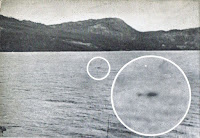Our Nessie man in Bradford, Gordon Holmes, continues to get publicity on his 2007 video of a strange object making its way up Loch Ness.His local newspaper has chimed in with a video of Gordon talking about his film as well as further information.
The article can be found
here and it seems it was making sufficiently big headlines.
A LOCH Ness monster hunter from Shipley believes he could finally have
helped solve the mystery of what really lurks beneath the water.
A computer expert in the US has used advanced techniques to analyse
a night-time film Gordon Holmes shot from a layby almost a decade ago.
The analysist has now concluded the creature side-winding across the
800ft deep Scottish loch at about 6mph might in fact be a giant eel.
On May 26, 2007 Mr Holmes, of Shipley,
was about to to finish Nessie-spotting for the day when he had his
'lucky break' looking through binoculars and had to make a mad-dash for
his camcorder.
The fascinating which appeared to show the black, long-necked
monster-like creatures with flippers moving close to the surface
swimming in the direction of Inverness, hit headlines worldwide ending
in a media-frenzy.
"There's been lots of opinions on what I filmed that night," said 63-year-old Mr Holmes, a retired university IT technician.
"They do look eel-like on my film and I did say that back in 2007. One
thing all the experts have agreed on is that my footage isn't fake."
The film has been newly analysed by Bill Appleton, chief executive of
US-based software firm DreamFactory, who was able to reduce camera shake
and make the images clearer.
Mr Holmes said: "Unless they discover some unknown creature from the
depths of Loch Ness, I believe Bill has finally solved this major
mystery in my life and the lives of many others.
"He is not David Attenborough but he is an expert in his own field.".
Mr Appleton has told leading Loch Ness investigators that Mr Holmes'
footage had framed giant eels, concluding: "I believe they display a
giant eel side-winding across the loch.
"The animal is at least 10ft long, maybe 15f. You can see in some
frames the classic, Plesiosaur neck, but this is just the eel moving
away from the camera."
Mr Holmes, who has featured in a TV show called Missing Evidence,
plans to return to Loch Ness later this year with a new drone he has
been test-flying over Ilkley Moor.
He said: "Of course the mystery and intrigue will go on.
"Unless I had concrete proof and the Loch Ness monster came out of the
water, shook hands with me, then safely went back into the water I
still can't be 100 per cent certain what it is and even if I was
fortunate enough to get all of that on camera there would still be
people who would not believe it.
"With progression of science and software we are getting closer to the
truth but we might be narrowing it down to more realistic things."
Mr Holmes' first visit to Loch Ness to try to unravel the legend was
in 2003 after his mother Winifred died from Alzheimers. She had given
him a tiny glass ornament of Nessie bought from a gift shop in Saltaire when he was 12 and he has been fascinated ever since.
Equipment he has built so far in a bid to track the real Loch Ness
monster has included a hydrophone to pick up sound signals in the water,
a spy in the sky camera carried by ten helium-filled foil balloons and
now a new drone and a special raft trialled out at sea off Bridlington
which will carry a weather-system and a camcorder.
"I will keep going back. My search isn't over yet," he said.














